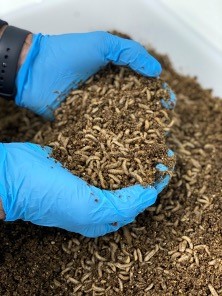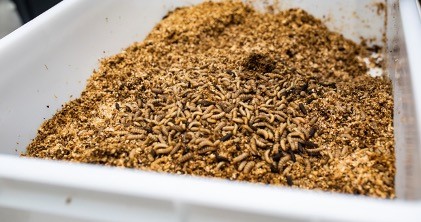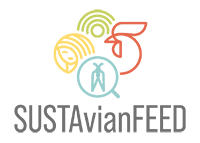SUSTAvianFEED project confirms the relevance of its goals and the importance of pilot projects to make progress in the animal feeding system
Last August 2021 the EU Commission made public the amending Annex IV to Regulation (EC) No 999/2001 of the European Parliament and of the Council as regards the prohibition to feed non-ruminant farmed animals, other than fur animals, with protein derived from animals, which now authorizes insect proteins in poultry and pig feed.
Prior to the entry into force of this piece of legislation, in September 2021, the use of insect proteins was not allowed in the European Union Member States – with the exception of the aquaculture and pet food market, feed for fur animals and other nonfood producing animals (as defined in article 18 of Regulation (EC) No 1069/2009).
This is an important news for the SUSTAvianFEED project, which confirms the relevance of the goals put in place and the importance of pilot projects to make progress in the animal feeding system.
In effect, SUSTAvianFEED aims to demonstrate innovative poultry farming systems by the inclusion of sustainable animal feeding. The project is developing a sustainable nutritional formula for poultry farming in which insects will play a key role and which will lead to an innovative poultry farming approach that could, in some way, make its part in the fight against climate change.
Organic waste is one of the biggest contributors to global warming.
The climate impact from the animal industry waste comes primarily from methane, produced from the anaerobic decomposition of the manures during storage and landfill. Treating the animal organic waste with BSF will ultimately reduce the amount of methane which is responsible for the greenhouse effect. It will not just reduce the quantity of organic wastes that may end up in landfills, but the wastes are also converted by the larvae into biomass and leaving a frass which is good source for compost.
“The recent approval of the new European Union Regulation authorizing the use of processed animal proteins derived from insects in poultry and pig feed has been very well received in this sector. – according to Diego Amores, CEO of EntomoAgroindustrial, a leader in Spain in the rearing of black soldier fly larvae, used for this purpose, and partner of the project – Currently, the use of insects as bio converters allows the valorization of organic matter into high quality products, such as proteins for animal and human food, fats (for use in detergents, industrial oils or the cosmetics industry), chitin and chitosan (for activities ranging from water purification to the pharmaceutical industry) or substrates for crop fertilization. Chitosan consumption in Europe alone is currently around 6,000 tons but is expected to exceed 12,000 tons by 2024”.

In the field of animal feed, the protein obtained from the black soldier fly (Hermetia illucens), which is produced by the Spanish company Entomo Agroindustrial, is used for nutritional purposes and functional feed in some animals, until now essentially for aquaculture feed, whose production in Spain grew by 2.9% in 2019, reaching 180,562 tonnes.
“The approval of the use of insects in pig and poultry feed – Amores continues – represents a great challenge for the sector. However, we must not forget that this is not just a sort of green light for production and therefore an increase in quantities. In fact, we must not forget the quality of our production, which then spills over to the entire animal chain”.
The European Union is the world’s second largest producer of pork after China and the largest exporter of pork and pork products. The main EU producing countries are Germany, Spain and France, which between them account for half of total EU production. It is also one of the world’s largest producers of poultry meat and a net exporter of poultry products, with an annual production of around 13.4 million tons.
“With the current legislation, – Amores explains – insect protein for animal feed can only come from insects fed with vegetable by-products. We hope that by the middle of next year there will be a legislative change that will allow the use of animal-based raw materials to feed insects.
In this context, “Spain must continue to reduce its dependence on foreign sources of protein for animal feed. With the technology derived from the use of insects, we are able to convert bio-waste into raw materials with high added value, including protein, thus boosting the circular economy,” he says.
The new legislation responds to the growing use of insects as a food protein in many different industries and also follows the recommendations of the EFSA (European Food Safety Authority) in relation to avoiding the risks of pathogens in the feeding and production of feed with insects to prevent them from being vectors of diseases or viruses, with the aim of ensuring the methods and standards of hygiene and safety in processing farms.

In addition to addressing prevention and control, the new regulatory text stresses the importance for the EU to reduce its dependence on protein supply.
And it argues that, from a nutritional point of view, processed animal proteins are an excellent raw material for animal feed, with a high concentration of highly digestible nutrients, such as amino acids and phosphorus, and a high vitamin content.
Last but not least, it remains very important to improve animal health and welfare. Feeding birds with insects will improve their native behavior and gut health, thus it would reduce the use of medicated feeds, which is related to antibiotic resistance, in the One Health’s perspective.
In this framework, the SUSTAvianFEED partners are working together to develop a sustainable nutritional formula for poultry farming through the use of insects and the substitution of protein sources with high and negative environmental impact (as soybean or fishmeal) in the poultry feeding programs by regional agri-food sector by-products in order to follow circular economy principles. Life Cycle Assessment (LCA) techniques or similar are used to determine the sustainability improvements of this approach.
In the SUSTAvianFEED project, ENTOMO analyses what is the potential to produce different insects in each area involved in the project.
To carry out the activity, personnel from ENTOMO is visiting each location in order to collect data on possible inputs (feedstock), connection with other areas, insect feedstock sources and place of consumption of the waste and interviews with the involved actors. With the information collected, an analysis of the situation will be done to better understand which kind of production site make more sense, considering production performance, community needs and the possibility to create a local knowledge in insect farming to be implemented beyond the time scope of the project. The result of the analysis will be used as a base for the implementation of insects’ farms at local sites.








Leave a Reply
You must be logged in to post a comment.